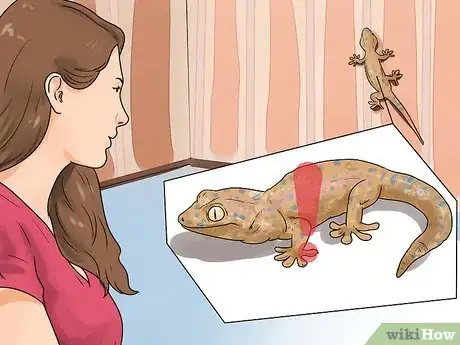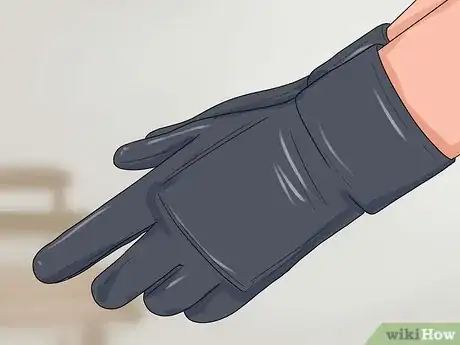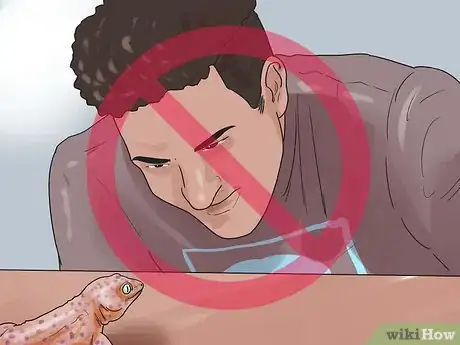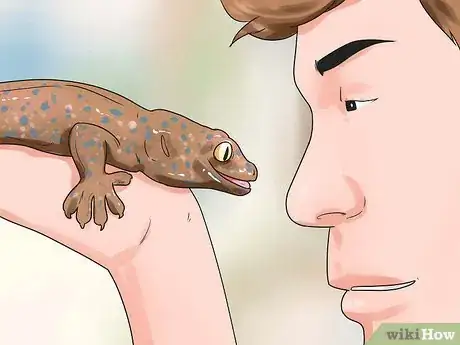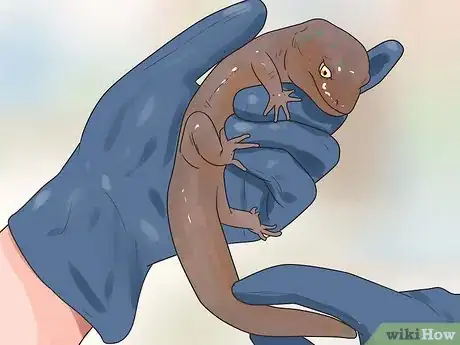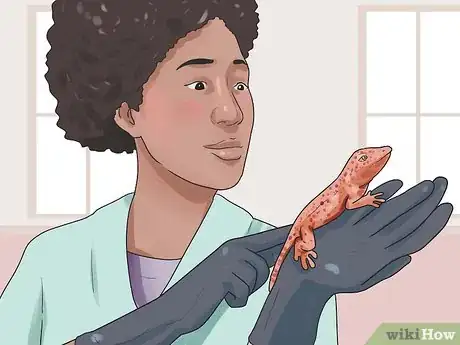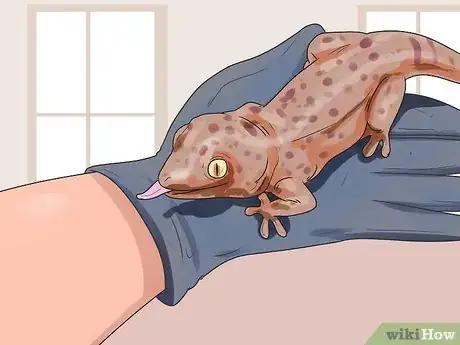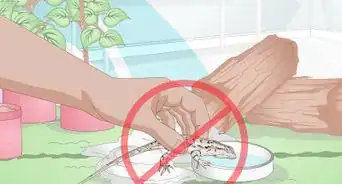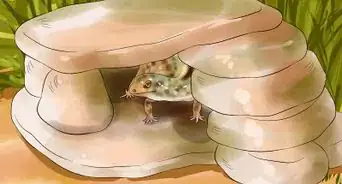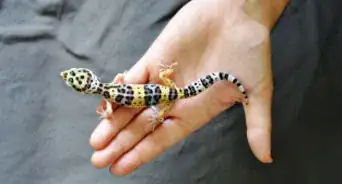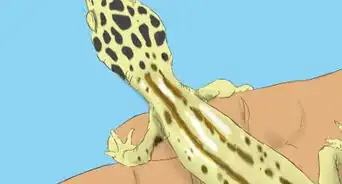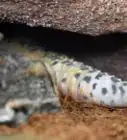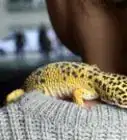This article was co-authored by Audra Barrios. Audra Barrios is a Marine Biologist and owner of Lick Your Eyeballs, a business offering experiemces, reptiles, supplies and plants. With over 15 years of experience, Audra specializes in reptiles and exotic animals, environmental education, marine biology, conservation issues, and animal husbandry. Audra earned a BASc in Marine Biology from the University of California, Santa Cruz, and studied Natural Sciences at the College of Marin. She is the founder and Executive Director of Things That Creep, a non-profit dedicated to herptile conservation through education. She has spent the last nine years working as a biologist at the California Academy of Sciences.
This article has been viewed 53,807 times.
The Tokay gecko is a second largest gecko species in the world, and has a coloration of blue to grey, with yellow or red spots.[1] These geckos are often referred to as the “Pitbull of the Gecko world”, as they have an aggressive, fearless attitude.[2] Though they are known to bite if threatened, the Tokay’s natural beauty and modest price point have made them very popular pets. While Tokay's can't necessarily be tamed, if you handle your Tokay from a young age and are patient, you may be able to help it warm up to you.[3]
Steps
Handling Your Tokay Gecko
-
1Gain the respect and trust of the gecko over a period of several months. Tokay geckos are known to be temperamental and can respond aggressively if they are not comfortable with you. Take your time to bond with your Tokay over a period of several months before you try to handle him.[4] Providing excellent care for your Tokay will show him you can be trusted and get him more used to your presence.[5] [6]
-
2Use thick gloves. The Tokay gecko’s bite can be quite painful and your gecko may latch on to your skin for up to an hour. To avoid being bitten, always use thick gloves when you are handling your Tokay.[7]
- If you do not have access to thick gloves, it is not advised that you try to handle your Tokay. If you need to subdue the Tokay to clean his cage or remove an item from his cage without gloves, you can restrain him by gently pinning his head down and wrapping your fingers around his neck and body. However, this is very stressful for the gecko and should only be done when necessary.[8]
Advertisement -
3Be prepared to be bitten. Many reptile experts argue against handling your gecko unless absolutely necessary due to their territorial nature and fierce bite. Only work on taming your gecko once you have owned him for a period of several months to a year and feel you are both ready for handling.
- If you are bitten by your Tokay while handling him, you can try dabbing one to two drops of white vinegar on his snout to get him to release his bite. You can also try dipping him in lukewarm water to get him to release his grip. Try to get him to release his bite gently, as you do not want to injure or threaten him.
Bonding with Your Tokay Gecko
-
1Coax your Tokay out of his cage carefully and gently. Do this to avoid damaging his toe pads and to avoid spooking him. Call his name and offer up your gloved hand, holding it flat. If your Tokay moves towards you, slide your hand underneath him.[9]
- Most Tokays will run away from you if they are not comfortable being handled. Take this as a sign to try the taming session again the following day, when the Tokay may be more interested in having contact with you.
-
2Avoiding looking directly at the Tokay. Your eyes can be intimidating to your gecko. You can look away and watch your gecko from the corner of your eyes.
-
3Hold the Tokay over your head. If your Tokay is comfortable sitting on your hand, raise your hand so it is over your head. Your eyes can be intimidating to your gecko. Placing him above you will allow him to get used to being on your hand.[10]
- Your Tokay may break a limb or injure himself if he leaps off of a hand and drops a long way to the floor. You may want to sit on the floor while you handle him to avoid injury to your Tokay.
-
4Stroke the underside of the gecko’s tail. Once the gecko seems to be sitting comfortably on your hand, keep him above your head and use your finger to lightly stroke him. Do this for several minutes and then gently put the gecko back into his cage.[11]
- Your Tokay may get spooked and run away from you, launching himself into the air and landing on the floor. Be prepared for this by doing a taming session in an open area that does not have any objects or spots where he can hide when he lands on the floor.
- It can take several taming sessions to get your gecko comfortable enough to be stroked by you, so be patient and go slow. Do several taming sessions throughout the week and build up to stroking the underside of his tail. You need to show your gecko that you are not going to harm to threaten him when you coax him out of his cage.
-
5Bring your gecko to body level and stroke his tail. If your gecko seems comfortable with being stroked above your head, you can work to slowly bring him down to body level. Continue to stroke the underside of his tail and try to coax him to walk from the back of one of your hands to the other hand.[12]
-
6Notice if he licks your hands as he walks on them. If your gecko is open to walking back and forth on your hands, this is a good sign he is calm and curious about being handled by you. As he walks back and forth, he may lick as he walks, tasting his environment. If you notice him doing this, you are close to having a friendly, tame Tokay.[13]
- Once your Tokay is calm and tame, he will rarely bite you and will remain pretty docile in your hands. However, you should not handle your Tokay without gloves, even if he appears tame, to reduce your risk of a nasty Tokay bite.
Expert Q&A
-
QuestionAre geckos harmful to humans?
 Melissa Nelson, DVM, PhDDr. Nelson is a Veterinarian who specializes in Companion and Large Animal Medicine in Minnesota, where she has over 18 years of experience as a veterinarian in a rural clinic. She received her Doctor of Veterinary Medicine from the University of Minnesota in 1998.
Melissa Nelson, DVM, PhDDr. Nelson is a Veterinarian who specializes in Companion and Large Animal Medicine in Minnesota, where she has over 18 years of experience as a veterinarian in a rural clinic. She received her Doctor of Veterinary Medicine from the University of Minnesota in 1998.
Veterinarian Despite their sometimes aggressive behavior, most geckos are ultimately not harmful to humans.
Despite their sometimes aggressive behavior, most geckos are ultimately not harmful to humans. -
QuestionHow big do Tokay Geckos get in the wild?
 Melissa Nelson, DVM, PhDDr. Nelson is a Veterinarian who specializes in Companion and Large Animal Medicine in Minnesota, where she has over 18 years of experience as a veterinarian in a rural clinic. She received her Doctor of Veterinary Medicine from the University of Minnesota in 1998.
Melissa Nelson, DVM, PhDDr. Nelson is a Veterinarian who specializes in Companion and Large Animal Medicine in Minnesota, where she has over 18 years of experience as a veterinarian in a rural clinic. She received her Doctor of Veterinary Medicine from the University of Minnesota in 1998.
Veterinarian Tokay geckos can grow up to 35 centimeters in length. This is an estimate for male tokay geckos.
Tokay geckos can grow up to 35 centimeters in length. This is an estimate for male tokay geckos. -
QuestionAre Tokay gecko aggressive?
 Melissa Nelson, DVM, PhDDr. Nelson is a Veterinarian who specializes in Companion and Large Animal Medicine in Minnesota, where she has over 18 years of experience as a veterinarian in a rural clinic. She received her Doctor of Veterinary Medicine from the University of Minnesota in 1998.
Melissa Nelson, DVM, PhDDr. Nelson is a Veterinarian who specializes in Companion and Large Animal Medicine in Minnesota, where she has over 18 years of experience as a veterinarian in a rural clinic. She received her Doctor of Veterinary Medicine from the University of Minnesota in 1998.
Veterinarian Yes tokay geckos are known to be aggressive, hard to handle, and quick to bite. You can overcome these obstacles though, most tokay geckos are ultimately harmless.
Yes tokay geckos are known to be aggressive, hard to handle, and quick to bite. You can overcome these obstacles though, most tokay geckos are ultimately harmless.
Warnings
- Tokay bites can be very painful, so always handle your Tokay with care.[14]⧼thumbs_response⧽
References
- ↑ http://www.thereptilian.co.uk/care_sheets/tokay_gecko_gekko_gecko_care_sheet.htm
- ↑ http://www.reptilesmagazine.com/Wild-Lizards/Look-Tokay-Gecko/
- ↑ Audra Barrios. Marine Biologist & Reptile Specialist. Expert Interview. 18 August 2020.
- ↑ Audra Barrios. Marine Biologist & Reptile Specialist. Expert Interview. 18 August 2020.
- ↑ http://www.thereptilian.co.uk/care_sheets/tokay_gecko_gekko_gecko_care_sheet.htm
- ↑ http://www.alsipnursery.com/tokay-gecko-care
- ↑ http://www.thereptilian.co.uk/care_sheets/tokay_gecko_gekko_gecko_care_sheet.htm
- ↑ http://www.thereptilian.co.uk/care_sheets/tokay_gecko_gekko_gecko_care_sheet.htm
- ↑ http://www.reptilesmagazine.com/Tokay-Gecko-Care/
- ↑ http://www.reptilesmagazine.com/Tokay-Gecko-Care/
- ↑ http://www.reptilesmagazine.com/Tokay-Gecko-Care/
- ↑ http://www.reptilesmagazine.com/Tokay-Gecko-Care/
- ↑ http://www.reptilesmagazine.com/Tokay-Gecko-Care/
- ↑ Audra Barrios. Marine Biologist & Reptile Specialist. Expert Interview. 18 August 2020.

